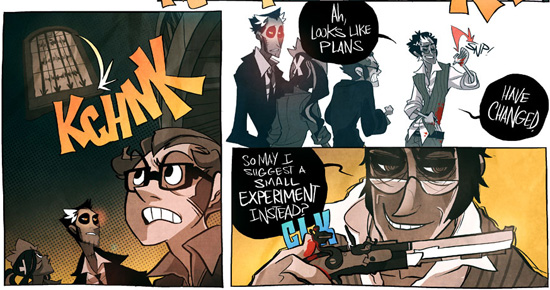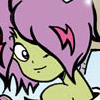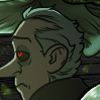Monthly Archives: November 2010
The Webcomic Overlook #144: Hanna Is Not A Boy’s Name

The root of “Hanna” is “Hannah.” It is Hebrew for “God has favored me.” The earliest use is in the Bible. She prayed to God for a son, and in exchange she promised that her son, the prophet Samuel (for whom two books of the Bible are named), would be given back to God in the service of the Shiloh priests.
Notable Hannas include Hanna Newcombe, a Canadian peace activist; Hanna Reitsch, a Nazi propaganda icon who was the only woman awarded the German Iron Cross First Class and the Luftwaffe Combined Pilots-Observation Badge in Gold with Diamonds during World War II; and Hanna Pakarinen, a pop singer who was the first winner of Finland’s Idols singing competition.
Also, Hanna is not a boy’s name.
That’s the controversial, hetero-normative statement proposed in the title of Tessa Stone’s comic, Hanna Is Not A Boy’s Name. With a title like that, you’re probably expecting an introspective webcomic exploring gender stereotypes. Perhaps it will delve into someone’s painful experiences growing up, taunted by bullies because of his name and gaining the strength to carry on like that boy named Sue.
And you’d be wrong. Hanna Is Not A Boy’s Name is actually about a zombie. And a werewolf. And a vampire. Actually, vampires. And some sort of supernatural detective agency. But I seriously can’t blame you if the title blindsided you.
Know Thy History: The Yellow Kid

Surely you’ve heard of the phrase “yellow journalism.” It’s the sort of unprincipled journalism where little research is done, and its sole purpose is to sell newspapers. It’s first use happened way back in the 1890’s between two newspaper titans: Joseph Pulitzer of New York World (yes, that Joseph Pulitzer) and William Randolph Hearst of New York Journal. “Yellow journalism” was infamously applied to the Spanish-American War. Hearst and Pulitzer first drummed up anti-Spain sentiments with fabricated stories about brutality in Cuba. The two papers went into full crazy warmongering mode when the USS Maine exploded. To this day, no one really knows if the Spanish were responsible for the sinking of the USS Maine. (Wikipedia provides several competing studies: the latest, based on computer simulations conducted by the National Geographic in 1998, helps support the original theory that a Spanish mine did sink the Maine, while a 1974 naval study concludes that it was spontaneous combustion of coal in the bunker near the magazine. As always, everything is wrapped up in politics.)
But why was it called “yellow journalism” in the first place? It turns out Pulitzer and Hearst had been fighting another war at the same time: one in the funny pages. Each had their own version of the character known as The Yellow Kid. When the media wars erupted, the New York Press called it “yellow journalism.”
The term isn’t as directly tied to the Yellow Kid as previously thought (even Wikipedia makes this error, claiming that “yellow journalism” was shortened from “yellow kid journalism”). However, there IS a connection, as reported by Comic Book Resources. “Yellow journalism” referred more to the fancy new yellow ink that the new newspapers were playing with. That ink was most visually seen in a popular comic where a kid wore a loud yellow shirt. In addition, the editor of the New York Press who coined “yellow journalism” was totes mad with this newfangled trend his competitors were using of mixing comics with serious, honest news reporting… and this bald-headed interloper wasn’t making matters easy.
And that, people, is how one of the early superstars of comics got mixed up with the sinking of the USS Maine.
The Yellow Kid got his start in Richard Outcault’s comic, Hogan’s Alley. It was the Li’l Rascals before there were L’il Rascals: bunch of kids growing up in the turn-of-the-century tenements and saying things wise beyond their years like “Our rejuced means may temporary necessitate our residin’ in a rear tenement, but we’re jist as exclusive as when we lived on the first floor front and papa had charge of the pound in the Department of Canine Captivity!” Oh, the hilarity! The Yellow Kid was just one of many of the Hogan’s Alley gang, a weird bald kid who had no hair because that’s how they treated lice infections in the day.
Back when Hogan’s Alley was in glorious black and white, the Yellow Kid wasn’t yellow at all. And even with the advent of color, The Yellow Kid was wearing some dowdy grey shirt. Yellow ink didn’t dry well, so when it was used, it was used sparingly. However, once the newspapers hit on a new, fast drying yellow ink, The Yellow Kid got his famous new duds, and a star was born. Ah, man, don’t you miss the days when “fast-drying yellow ink” was the “Flash Animation” of new technologies?
So that’s why he’s The Yellow Kid. I thought that he was a racist caricature of an Asian American, but there doesn’t seem to be anything online to yet support this theory. I mean, other kids in Hogan’s Alley were drawn rather offensively, “yellow” is sort of associated with Asian skin color, and The Yellow Kid did dress the part for visiting Chinese dignitaries … but if you look at what’s written on the shirt in that last link you’ll notice that he implies he’s not from China, so there you go. So that’s that.
Speaking of shirts: The Yellow Kid didn’t speak much, but he had one of the most expressive shirts in the business. It even changed from panel to panel, doubling as The Yellow Kid’s dialogue. It was also a parody of turn-of-the-century advertising techniques, where people primarily advertised with quirky slogans printed on t-shirts. My, how things have changed.
Read the rest of this entry
Foxtrot does webcomics, Part Three (or everybody does xkcd)
It seems that while Randall Munroe is out taking care of family issues, we currently have a parade of xkcd cartoonists doing guest comics. Earlier, there was a comic done by Questionable Content‘s Jeph Jacques. And now, we have FoxTrot‘s Bill Amend stepping up to the plate.
Now, I understand that Randall Munroe probably didn’t have much time to line up his guest artists, and he probably had a lot more important things on his mind.
Still, these strips are getting quite a bit of attention … and personally speaking, I don’t think they’re very good. These guest artists can’t incorporate any of their own artistic styles into the comic, and thus have to fall back on the writing. And if Munroe is good at anything, he’s at least pretty good at repurposing higher-level physics and mathematics concepts into humor. As they stand, they’re, at best, dumbed down xkcd‘s … and, at worst, cheap knock-off xkcd‘s, and Lord knows the internet is chock full of those already.
I sorta wish that the guest xkcd‘s would have gone one of two avenues:
1.) The guest creators would have been writers who are more familiar with this sort of mathematical based humor. They shouldn’t have to necessarily even be from the comics field. Maybe a funny professor acquaintance of Mr. Munroe’s. Or a funny former co-worker at NASA.
I mean, stick figures. Everyone can draw ’em.
2.) Let the guest artists run free on putting in their own artistic touches. Just like those Dinosaur Comics guest strips. Those can get pretty spectacular.
John Allison, UK Indie Comics, the lowdown

So pretty much everyone from Comixtalk to Fleen to Robot 6 to Storming the Tower to ComixTalk has already commented on John Allison’s manifesto for UK Indie Comics which also has to do with webcomics. I probably would have commented on it earlier, but I’ve been pretty sick the back half of the week and part of that means that my brain’s too toasted to put together a decent post half the time. (Incidentally, it only takes you one day to realize you miss the taste of food.)
It’s a good list and there’s very little I disagree with. I’m not going to say much more since everyone else covered all the bases. However, I admit that I really liked this part:
9. A scene that celebrates itself has nothing to celebrate
The affirmation of your work by your friends in a small scene means nothing. No one is going to tell you that your work is bad to your face and risk being ostracised. Seek the widest audience for your work, if that’s what you want, then ask yourself why things are or aren’t working.
Awwww. Does that mean you liked my less than flattering review of Bad Machinery, John?
Random Quickies: Hipster Hitler

So how long does it take before jokes about Hitler being a hipster get old and tired? You’d think after one strip, right? And yet somehow Hipster Hitler hasn’t jumped the shark. This may be some sort of accomplishment for something that already did a gag where Hitler wears an “I Love Juice” shirt. Maybe seeing Hitler wearing skinny jeans and ironic tees has more staying power than previously assumed. Or maybe there aren’t enough webcomics out there actively engaging in quality hipster bashing.
The Webcomic Overlook #143: Party Bear

Most webcomics are written by nerds for nerds. It’s a fact of life. People who draw webcomics have a certain passion for comics and an acuity in computers. That spells N-E-R-D-S.
As a strange result, webcomic settings are not only the same, they’re typically squeaky clean. Take your typical slice-of-life webcomic. They’re usually either set in college, or at high school, or in the comforting embraces of suburbia. The closest you get are stories about jobless post-college slackers who sit on their couch and complain about having no money. But how poor can they possibly be if, in every other scene, we usually see them tapping way at their XBox controllers?
Thus, it’s rather unique when I encounter a webcomic set in the more unconventional world of the inner city. It’s the world popularized, mythologized, exaggerated, and romanticized by gangsta rappers and filmmakers like Spike Lee and John Singleton. It’s where the windows of crumbling brick buildings are barricaded by black iron grates. Where drug dealers are a fact of life. And where you’re always under the thumb of The Man.
But, hey, it’s life, and you get by. Especially if you’re protected by a bear. A Party Bear.
Know Thy History: Ally Sloper

Horseless carriages ain't nothing but trouble, amirite fellas?
So, class, who was the first comic character?
“Superman!” you say!
No, shut up.
“Um, The Yellow Kid?” You’re getting closer. The Yellow Kid, created by Richard F. Outcault (who was also responsible for previous “Know Thy History” entrant Buster Brown) is often recognized as the first American comic character.

However, if we include our buddies from across the really big pond into the conversation, we’d be fools not to recognize Alexander Sloper… better known as “Ally” Sloper. The guy made his debut way back in August 14, 1867, appearing in Judy magazine (which was a wordplay on the popular periodical Punch). That’s nearly 150 years ago. Or nearly 100 years before Peter Parker donned his Spidey tights.
Ally Sloper — so named after a British collloquialism for people dodging the rent collector by sloping into the alley — was created by Charles H. Ross. He initially handled the illustrations with his wife, Emilie de Tessier, doing the inking duties. Eventually, though, all art duties were handled by Ms. Tessier (who was using the pseudonym Marie du Val). As you may expect, a lady drawing a comic was practically unheard of, ESPECIALLY since comic books didn’t really exist yet. Anyway, this power combo handled the Ally Sloper property for almost two decades.
Read the rest of this entry

















































































































